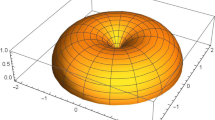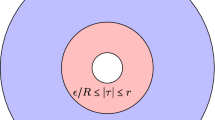Abstract
We describe the period matrix and other data on a higher genus Riemann surface in terms of data coming from lower genus surfaces via an explicit sewing procedure. We consider in detail the construction of a genus two Riemann surface by either sewing two punctured tori together or by sewing a twice-punctured torus to itself. In each case the genus two period matrix is explicitly described as a holomorphic map from a suitable domain (parameterized by genus one moduli and sewing parameters) to the Siegel upper half plane \({\mathbb{H}_{2}}\) . Equivariance of these maps under certain subgroups of \({Sp(4,\mathbb{Z})}\) is shown. The invertibility of both maps in a particular domain of \({\mathbb{H}_{2}}\) is also shown.
Similar content being viewed by others
References
D’Hoker E., Gutperle M. and Phong D.H. (2005). Two-loop superstrings and S-duality. Nucl. Phys. B 722: 81–118
Dong C., Li H. and Mason G. (1997). Regularity of rational vertex operator algebras. Adv. Math. 132(1): 148–166
Dong C. and Mason G. (2004). Rational vertex operator algebras and the effective central charge. Int. Math. Res. Not. No. 56: 2989–3008
Dong C. and Mason G. (2004). Holomorphic vertex operator algebras of small central charge. Pac. J. Math. 213(2): 253–266
D’Hoker E. and Phong D.H. (1988). The geometry of string perturbation theory. Rev. Mod. Phys. 60: 917–1065
D’Hoker E. and Phong D.H. (2002). Two-loop superstrings. I: Main formulas. Phys. Lett. B 529: 241–255
D’Hoker E. and Phong D.H. (2005). Two-loop superstrings. VI: Non-renormalization theorems and the 4-point function. Nucl. Phys. B 715: 3–90
Eichler M and Zagier D (1985). The Theory of Jacobi Forms. Birkhäuser, Boston
Farkas HM and Kra I (1980). Riemann Surfaces. Springer-Verlag, New York
Farkas, H.M., Kra, I.: Theta Constants, Riemann Surfaces and the Modular Group. Graduate Studies in Mathematics, Providence, RI: Amer. Math. Soc. 2001
Green M., Schwartz J. and Witten E. (1987). Superstring Theory Vol. 1. Cambridge University Press, Cambridge
Gunning R.C. (1990). Introduction to Holomorphic Functions of Several Variables Vol 1. Belmont, CA, Wadsworth & Brooks/Cole
Huang Y (1997). Two-Dimensional Conformal Geometry and Vertex Operator Algebras. Birkhäuser, Boston
Kaneko, M., Zagier, D.: A generalized Jacobi theta function and quasimodular forms. In: The Moduli Space of Curves (Texel Island, 1994), Progr. in Math. 129, Boston: Birkhauser, 1995
Moore G. and Seiberg N. (1989). Classical and quantum conformal field theory. Commun. Math. Phys. 123: 177–254
Mason G. and Tuite M.P. (2003). Torus chiral n-point functions for free boson and lattice vertex operator algebras. Commun. Math. Phys. 235: 47–68
Mason, G., Tuite, M.P.: The genus two partition function for free bosonic and lattice vertex operator algebras. To appear
Mumford D. (1983). Tata Lectures on Theta I and II. Birkhäuser, Boston
Polchinski J. (1998). String Theory, Volume I. Cambridge University Press, Cambridge
Serre J-P. (1978) A Course in Arithmetic. Berlin, Springer-Verlag
Stanley R.P. (1999). Enumerative Combinatorics, Volume 2. Cambridge University Press, Cambridge
Sonoda, H.: Sewing conformal field theories I. Nucl. Phys. B311, 401–416 (1988); Sewing conformal field theories II. Nucl. Phys. B311, 417–432 (1988)
Springer G. (1957). Introduction to Riemann Surfaces. Addison-Wesley, Reading, MA
Tuite, M.P: Genus two meromorphic conformal field theory, CRM Proceedings and Lecture Notes 30, Providence, RI: Amet. Math. Soc., 2001, pp. 231–251
Verlinde E.P. and Verlinde H.L. (1987). Chiral bosonization, determinants and the string partition function. Nucl. Phys. B 288: 357–396
Yamada A. (1980). Precise variational formulas for abelian differentials. Kodai Math. J. 3: 114–143
Zhu Y. (1996). Modular invariance of characters of vertex operator algebras. J. Amer. Math. Soc. 9: 237–302
Author information
Authors and Affiliations
Corresponding author
Additional information
Communicated by Y. Kawahigashi
Support provided by the National Science Foundation DMS-0245225, and the Committee on Research at the University of California, Santa Cruz.
Supported by The Millenium Fund, National University of Ireland, Galway.
Rights and permissions
About this article
Cite this article
Mason, G., Tuite, M.P. On Genus Two Riemann Surfaces Formed from Sewn Tori. Commun. Math. Phys. 270, 587–634 (2007). https://doi.org/10.1007/s00220-006-0163-5
Received:
Accepted:
Published:
Issue Date:
DOI: https://doi.org/10.1007/s00220-006-0163-5




